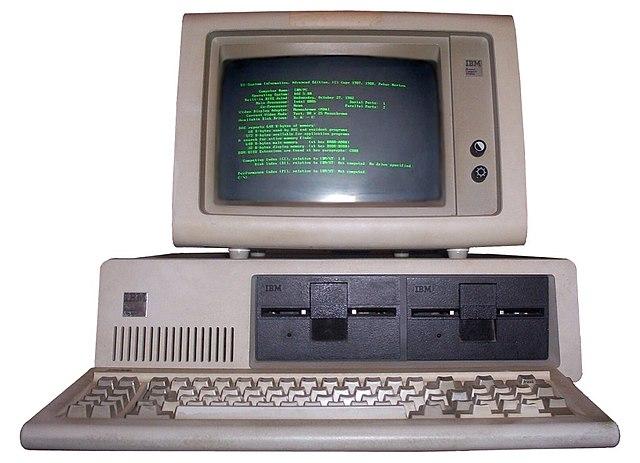
most famous computer
The name of this machine has already been mentioned here, and in the most unflattering context: as a computer that undeservedly enjoys the fame of being the first in the world. The fact that others have overtaken him? including secret British colossi and Conrad Zusi's machines; I already wrote about them here. Let us, however, honor him; the more it approaches the beautiful round anniversary of its 65th anniversary. It does not matter that he has been retired for many years. ENIAC.
Since the construction of this machine, the world has become a completely different place. Probably, no one expected such consequences with this device, which we are seeing today. Perhaps only ... sensationalist journalists who called this machine an “electronic brain”. By the way, they gave her away and? Seriously? Informatics does a disservice, causing fierce criticism with this term both from orthodox materialists (who regard life as a form of protein existence), and fideists, outraged by one hint that a person can create any form of intelligence ...
Thus, in 1946, the era of computers officially began. The exact date is difficult to establish: could it have been February 15, 1946, when the public was informed of the existence of ENIAC? Maybe on June 30 of the same year, when the period of experimental calculations was closed and the car was transferred to its owner, i.e. US army? Or maybe you need to go back a few months to November 1945 when ENIAC issued its first invoices?
However we decide, one thing is certain: sixty-five years are over.
ELECTRONIC MONSTRUM
When ENIAC was shown to journalists, it was obvious that no one had ever built such a monster, at least in the field of electronics. Arranged in a 12m by 6m U-shaped rectangle, forty-two cabinets of black-painted steel sheet steel—each 3m high, 60cm wide, and 30cm deep—were filled with 18 vacuum tubes of sixteen types; they also contained 800 6000 switches, 1500 relays and 50 000 resistors. For all this, according to representatives of the press, 0.5 million welds were required, which had to be done by hand. The monster weighed 30 tons and consumed 140 kW of power. Built into its ventilation system were two Chrysler engines with a combined horsepower of 24; each cabinet was equipped with a manually operated humidifier, and a thermostat would stop all "monstrous" work if the temperature inside any part of it exceeded 48°F. Further, in the room intended for the car, there were three additional - also stuffed with electronics - even larger than the rest, sliding wardrobes on wheels, attached as needed in the right place to the set. They were complemented by a reader and perforators for punched cards.
What did he think?
ENIAC() calculated - unlike modern computers - in decimal system, operating on ten-digit numbers, positive or negative, with a fixed position of the decimal point. Its speed, dizzying for the scientists of the time and completely unimaginable for the average person of the time, was expressed by five thousand additions of such numbers per second; and to think that personal computers, which are considered not very fast today, are thousands of times faster! If necessary, the machine could work with numbers? Double precision? (twenty-digit) with a variable position of the decimal point; of course it was slower in this case and its memory footprint decreased accordingly.
ENIAC had a typical modular structure. As he speaks Robert Ligonier in his book on the history of computer science, his architecture was based on hierarchical systems of varying complexity. Inside the cabinets mentioned above were relatively easily replaceable panels containing various sets of electronic components. Such a typical panel was, for example, a "decade", which could record the numbers from 0 to 9 and generate a carry signal when added to the next such system - this is a kind of electronic equivalent of digital circles from Pascal's adder of the 550th century. The main elements of the machine were "batteries" that could "remember?". decimal numbers, add them up and pass them on; each of these batteries contained XNUMX lamps. The number stored in a given battery could be read by the location of the neon lights on the front of the respective cabinet.
Pedigree
The idea for ENIAC was born from the needs of the computational war. One of the typical accounting problems of the XNUMXs was the preparation of ballistic tables for artillery. Such a table is simply a set of coordinates of the projectile flight path, allowing the soldier to correctly position (aiming) the projectile, taking into account its type, projectile model, chemical composition and size of the propellant charge, air temperature, wind strength and direction. , atmospheric pressure and some other similar parameters.
From a mathematical point of view, the compilation of such tables is a numerical solution of a certain type of so-called. hyperbolic differential equations in two variables. In practice, the track was then calculated for 50 intermediate points. In order to obtain the corresponding values in one of them, it was necessary to perform 15 multiplications, which meant that calculations along one trajectory took 10-20 minutes of work for the most technically advanced specialized computer at that time, which was a differential analyzer. Taking into account other measures required to compile the table of actions - one complete table required 1000-2000 computing hours, i.e. 6-12 weeks. And such boards had to be built tens of thousands! If we used the most advanced multiplier from IBM for this purpose, it would take another year of work!
Creators
The story of how the US military tried to deal with this monstrous problem is worthy of a science fiction film. Recruited from Princeton by the project leader, an outstanding, although not very young, Norwegian mathematician Oswald Vebelenwho carried out similar calculations in 1917; in addition, 7 more mathematicians, 8 physicists and 2 astronomers worked. Their adviser was a brilliant Hungarian, John (Janos) von Neumann.
About 100 young mathematicians were drafted into the army as calculators, all usable computing equipment was confiscated for the army ... It was clear, however, that the needs of artillery would not be completely satisfied in this way. Fortunately - somewhat by accident - it was at this time that the life paths of three young people converged. They were: Dr. John Mauchly (born 1907), electronics engineer John Presper Eckert (born 1919) and Doctor of Mathematics, US Army Lieutenant Herman Heine Goldstein (born 1913).
J. Mauchly, back in 1940, spoke about the possibility of using electronics to build a calculating machine; he came up with this idea because of the huge calculations he had to do when he became interested in the applications of mathematical statistics in meteorology. Enrolling in special courses at the University of Pennsylvania, which train highly qualified specialists for the army, he met J.P. Eckert. This one, in turn, was a typical "handyman", a brilliant designer and performer: at the age of 8 he was able to build a miniature radio receiver, which he placed ... on the end of a pencil; at the age of 12 he built a miniature radio-controlled ship, two years later he designed and manufactured a professional sound system for his school. Both students liked each other immensely ... and in their free minutes they designed a huge calculator, a universal calculating machine.
However, this project came close to never seeing the light of day. Both scientists formally submitted it, in the form of a corresponding five-page memorandum, to one J. G. Brainerd, a member of the board of directors of the University of Pennsylvania in charge of relations with the US government. The latter, however, shoved the document into his desk (it was found there 20 years later - it was intact) and would have closed the case if not for the third? Father? ENIAC, Dr. G. G. Goldstein.
Dr. Goldstein worked at the aforementioned US Army Computing Center () and quickly looked for a solution to the already known problem of ballistic gratings. Fortunately, while conducting a routine inspection of the University of Pennsylvania military computer center, he told a student about his problems. It was a student of Mauchly who knew the memorandum... Goldstein understood the meaning of the new idea.
It happened in March 1943. About a dozen days later, Goldstein and Mauchly were taken over by the BRL leadership. Oswald Vebelen had no doubts: he ordered the immediate allocation of the necessary money for the construction of the machine. On the last day of May 1943, the name was established ENIAC. On June 150, the top-secret "Project PX" was signed, the cost of which was set at $486 (actually $804 cents). Work officially began on July 22, the first two batteries were put into operation in June of the following year, the entire machine was put to laboratory tests in the fall of 1, the first experimental calculations were carried out in November 1945. As we have already said, June 1945 30 ENIAC was handed over to the army, which confirmed the receipt of the “PX Project”.
Therefore, ENIAC did not take part in the war. Moreover, its activation by the army continued until July 29, 1947. But once launched and after very fundamental adjustments, put into operation - at the direction of von Neumann - he served in the army for quite a long time, calculating not only ballistic tables, but also analyzing options for building a hydrogen bomb, designing tactical nuclear weapons, studying cosmic rays, designing wind tunnels or, finally, completely “civilian” ones? – by calculating the value of a number up to a thousand decimal places. Ended service on October 2, 1955 at 23.45:XNUMX p.m. when it was finally disconnected from the mains and began to be dismantled.
It was to be sold for scrap; but the scientists who used it protested, and large parts of the machine were saved. The largest of these is today at the Smithsonian Institution in Washington.
Thus, in 148 months, ENIAC has gone from the designer's drawing board to the museum of technology, thus marking the beginning of an era of tremendous achievements in the development of computer technology. It does not matter that before him the name of the computer was earned by the machines designed by the brilliant German Konrad Zuse, as well as - as it turned out after the opening of secret British archives in 1975 - English computers from the Colossus series.
In 1946 the world met ENIAC and it will always be First to the public...

